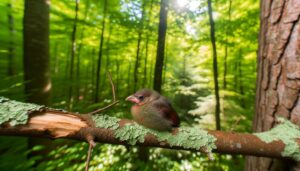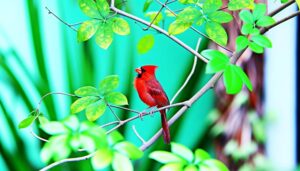Are There Cardinal Birds in Australia?
Cardinal birds, belonging to the family Cardinalidae, are native to the Americas and are mainly found in North and Central America. They inhabit forested regions, shrublands, and gardens, adapting to environments rich in cover and food sources like seeds and insects.
In contrast, Australia supports over 800 unique bird species, including parrots, honeyeaters, and emus, but does not have native cardinal birds. Australia's bird species are adapted to its diverse climates and habitats, ranging from rainforests to arid deserts.
Understanding these distinct habitats highlights the fascinating distinctions between Australian avifauna and cardinal birds.

Key Takeaways
- Cardinal birds are native to the Americas and are not naturally found in Australia.
- The Northern Cardinal is specific to North and Central America.
- Australia's unique bird species evolved separately, with significant endemism.
- Australian habitats support native birds like parrots, honeyeaters, and emus.
- No cardinal bird species have naturally established populations in Australia.
Origin of Cardinal Birds
The origin of cardinal birds can be traced back to their evolutionary roots in the Americas, where they belong to the family Cardinalidae within the order Passeriformes. This avian family is known for its striking plumage and melodious songs. Cardinalidae encompasses several genera, with the Northern Cardinal (Cardinalis cardinalis) being the most recognized species.
Fossil records and molecular studies suggest that these birds evolved approximately 20 million years ago during the Miocene epoch. Their development was influenced by climatic shifts and the availability of diverse habitats in North and South America. Adaptations such as strong beaks for seed consumption and vibrant feather coloration have enabled their survival and diversification, making them a prominent feature of the New World avifauna.
Habitats and Distribution
Cardinal birds primarily inhabit forested regions, shrublands, and gardens, where they can find ample food sources and nesting sites. Their distribution is largely confined to the Americas, particularly North and Central America. These habitats provide the dense vegetation necessary for their nesting and the diverse range of seeds, fruits, and insects that constitute their diet. Cardinals are non-migratory, meaning they remain within these habitats year-round, adapting to seasonal changes. Their preference for low to mid-elevation areas with abundant cover makes them well-suited for suburban and rural environments.
| Region | Habitat Type |
|---|---|
| North America | Deciduous forests |
| Central America | Tropical shrublands |
| Suburban Areas | Residential gardens |
This table highlights the cardinal bird's preferred habitats within their native distribution.
Australian Bird Species
Australia hosts a diverse array of bird species, each adapted to the continent's unique ecosystems and climates. The avian population includes over 800 species, with notable families such as the parrots (Psittacidae), honeyeaters (Meliphagidae), and the iconic emu (Dromaius novaehollandiae).
Endemism is significant, with over 45% of species found nowhere else. Examples include the splendid fairy-wren (Malurus splendens) and the laughing kookaburra (Dacelo novaeguineae).
Additionally, Australia is home to striking raptors like the wedge-tailed eagle (Aquila audax) and various seabirds, including the little penguin (Eudyptula minor).
This rich avian diversity results from evolutionary processes shaped by geographic isolation and varied habitats, ranging from arid deserts to lush rainforests, providing ample opportunities for niche specialization.
Climate and Environment
Understanding the climate and environment of Australia is fundamental to comprehending the distribution and behavior of its diverse avian species. Australia's climate varies from tropical in the north to temperate in the south, with vast arid and semi-arid regions in the interior. These climatic zones dictate the habitats available for bird species, ranging from rainforests and mangroves to grasslands and deserts.
The availability of water sources, vegetation types, and temperature gradients influences avian migration, breeding, and feeding patterns. Additionally, seasonal variations such as the monsoon in the northern regions and the dry season in the interior notably impact bird activities. This complex environmental mosaic shapes the ecological niches that Australian bird species occupy, thereby affecting their distribution across the continent.
Birdwatching in Australia
Birdwatching in Australia offers an exceptional opportunity to observe a myriad of avian species in their native habitats, ranging from coastal wetlands to arid desert landscapes. The continent's diverse ecosystems support over 800 bird species, including endemic varieties found nowhere else. Key locations like Kakadu National Park and the Great Barrier Reef provide rich environments for both novice and experienced birdwatchers.
| Habitat | Notable Species |
|---|---|
| Coastal Wetlands | Australian Pelican |
| Eucalyptus Forests | Laughing Kookaburra |
| Arid Desert Landscapes | Emu |
Australia's birdwatching hotspots afford unparalleled glimpses into avian behavior and ecology, providing invaluable data for ornithological studies and conservation efforts. This thriving avifauna underscores the continent's ecological richness and the importance of habitat preservation.
Conclusion
In the grand tapestry of avian life, cardinal birds, like vivid brushstrokes, paint the forests of the Americas with their striking colors.
However, in the symphony of Australia's unique fauna, these vibrant notes are absent. Instead, Australia boasts its own melodious ensemble, shaped by distinctive climates and environments.
Therefore, birdwatchers in the land down under revel in the native splendor of species adapted to its singular ecological stage, where the cardinal's call remains an unplayed melody.






